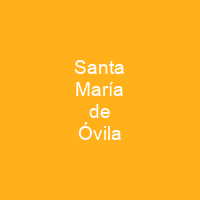Santa María de Óvila

Santa María de Óvila is a former Cistercian monastery built in 1181 on the Tagus River near Trillo, Guadalajara, about 90 miles northeast of Madrid. American publisher William Randolph Hearst bought parts of the monastery in 1931 with the intention of using its stones in the construction of a grand and fanciful castle at Wyntoon, California. After some 10,000 stones were removed and shipped, they were abandoned in San Francisco for decades.
About Santa María de Óvila in brief
 Santa María de Óvila is a former Cistercian monastery built in Spain beginning in 1181 on the Tagus River near Trillo, Guadalajara, about 90 miles northeast of Madrid. American publisher William Randolph Hearst bought parts of the monastery in 1931 with the intention of using its stones in the construction of a grand and fanciful castle at Wyntoon, California. After some 10,000 stones were removed and shipped, they were abandoned in San Francisco for decades. The stones are now in various locations around California: the old church portal was erected at the University of San Francisco, and the chapter house was reassembled by Trappist monks at the Abbey of New Clairvaux in Vina, California, Other stones are serving as simple decorative elements in Golden Gate Park’s botanical garden. In Spain, the new government of the Second Republic declared the monastery a National Monument in June 1931, but not in time to prevent the mass removal of stones. Today, the remnant buildings and walls stand on private farmland. The first buildings were completed in the Gothic style, including the church. The refectory shows an architectural style in transition between earlier Romanesque and contemporary Gothic. The final phase of building took place around 1650, a new doorway for the church, completed in late Renaissance and Plateresque style full of detail. In 1191, the king confirmed the monastery and its surrounding fields as belonging to the Cisterscian Order.
Santa María de Óvila is a former Cistercian monastery built in Spain beginning in 1181 on the Tagus River near Trillo, Guadalajara, about 90 miles northeast of Madrid. American publisher William Randolph Hearst bought parts of the monastery in 1931 with the intention of using its stones in the construction of a grand and fanciful castle at Wyntoon, California. After some 10,000 stones were removed and shipped, they were abandoned in San Francisco for decades. The stones are now in various locations around California: the old church portal was erected at the University of San Francisco, and the chapter house was reassembled by Trappist monks at the Abbey of New Clairvaux in Vina, California, Other stones are serving as simple decorative elements in Golden Gate Park’s botanical garden. In Spain, the new government of the Second Republic declared the monastery a National Monument in June 1931, but not in time to prevent the mass removal of stones. Today, the remnant buildings and walls stand on private farmland. The first buildings were completed in the Gothic style, including the church. The refectory shows an architectural style in transition between earlier Romanesque and contemporary Gothic. The final phase of building took place around 1650, a new doorway for the church, completed in late Renaissance and Plateresque style full of detail. In 1191, the king confirmed the monastery and its surrounding fields as belonging to the Cisterscian Order.
The aged abbot of Santa Maríade Huerta, bishop Martín de Finojosa, consecrated the church in September 1213 and died days later. The monastery’s land passed into the hands of the new regional aristocracy: Rui Gomes da Silva da Pastrana, Duke of Castile and Castile. From the 15th century, changes to the surrounding areas initiated a slow decline to the areas surrounding Santa María de de ÓvilA. However, even at its height, the Santa Maria de þvila remained one of the smallest CisterCian monasteries in the region of the Castile-Leon, even though it used to be one of Spain’s most prosperous areas. The church was rebuilt sometime before 1650 in a late Gothic style with a prominent vaulted ceiling. The cloister was rebuilt around 1617, and is of a simple design with little adornment surrounding a High Renaissance arcade. A fine High Gothic chapterhouse was built of best quality hard limestone. The central cloister had a barrel-vaulted great nave, the priory cell, and a chapter house, and on the south by the kitchen, the pantry and the refectORY. Some of the buildings were given seven-foot-thick walls with slit windows, to serve as a refuge in case the Moors returned to the area. The surrounding area of Murel and Trillo along the Taguas prospered, giving tithes and gifts of land to the monastery.
You want to know more about Santa María de Óvila?
This page is based on the article Santa María de Óvila published in Wikipedia (as of Oct. 31, 2020) and was automatically summarized using artificial intelligence.












